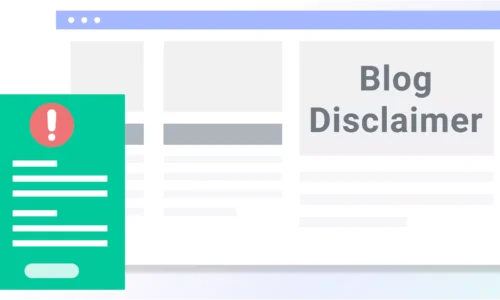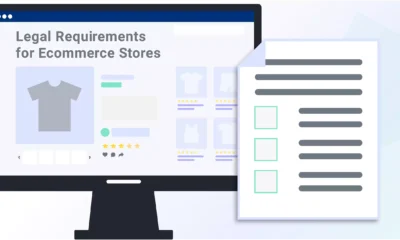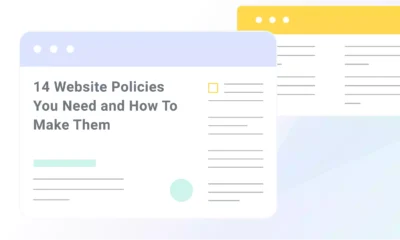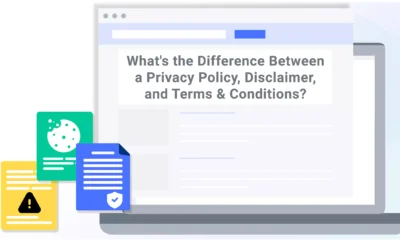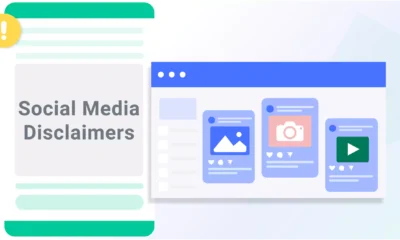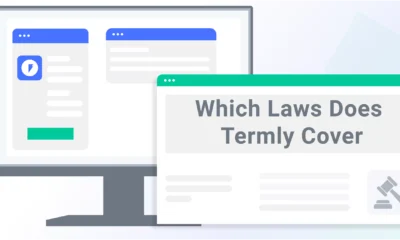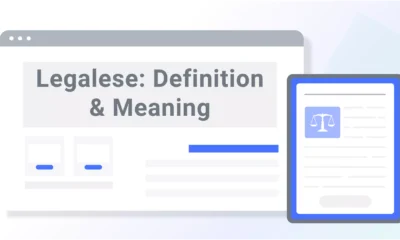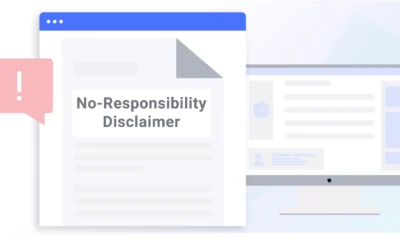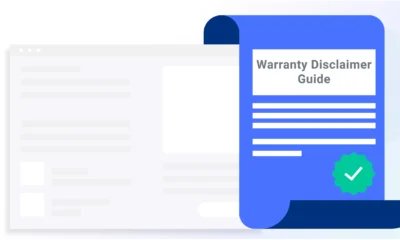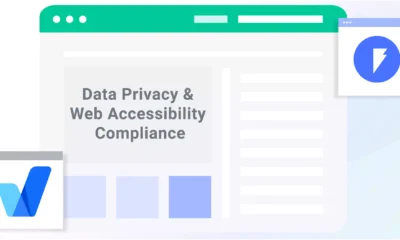If you own a website with a blog, it’s important to protect yourself and your users by posting a few standard disclosures.
For blog owners, well-placed disclaimers can help limit liabilities, disclose your relationship with affiliates, inform users to act on your content at their own risk, and alert them about other important information.
Keep reading to learn more about the most commonly used blog disclaimers, why they matter, and how to write your own.
How To Make Customized Blog Disclaimers
You can easily make customized disclaimers for your blog using a generator, a template, or writing them yourself.
Generate a Free Customized Disclaimer Using Termly
Here’s how to use Termly’s generator to create a custom blog disclaimer for your needs.
Step 1: Go to Termly’s disclaimer generator.
Step 2: Answer a few simple prompts and questions, and go through all the steps until you reach “Final Details.”
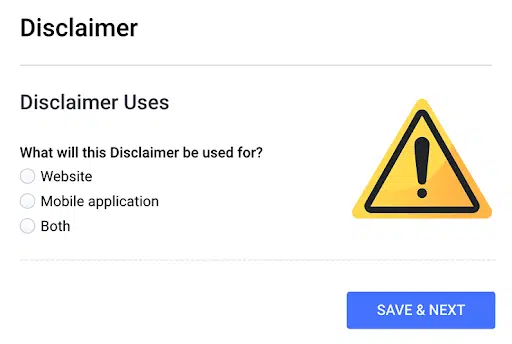
Step 3: Once you’ve filled in everything and are satisfied with the preview, click “Publish.”
You will then be prompted to create an account on Termly so you can save and edit your legal disclaimer further.
Use a Disclaimer Template
You can also use our disclaimer template to make unique disclaimers for your blog.
Just fill in the blank sections with information about your website and remove any portions that aren’t relevant to you.
You can then choose how you want to download it or embed it to your site.
Write Your Own Disclaimers
You also have the option to write your own disclaimers for your blog.
Blogs often benefit from multiple disclaimers throughout the site, so if you choose this method, consider the following questions:
- What products and/or services does my blog provide?
- Can acting on my content pose a risk to readers?
- Do I use affiliate links or receive compensation for blog posts?
- Do I share information or intellectual property created by other people? If so, am I engaging in fair use of that material?
- Do I own my content and want to express that to readers?
Make as many different disclaimers as necessary based on your responses to these prompts.
Then, link your disclaimer page in your site’s footer or main menu, and use standalone disclaimers on individual blog posts as needed.
What Are Disclaimers for Blogs?
Blog disclaimers help disclose important information to your site visitors, keeping them properly informed and removing some liabilities from your plate.
Here’s a quick list of different types of disclaimers relevant to blogs and what they do to help keep your website and readers safe:
The list above represents only a sample of the different types of disclaimers that exist.
You might need one or more of the above disclaimers depending on what you write about on your blog and who your audience is.
Do Blogs Need Disclaimers
Most blogs need one or more disclaimers either for legal reasons or to protect your business.
For example, if you’re in the U.S. and post affiliate links or have a material relationship with a brand, you must post an endorsement disclaimer in line with the Federal Trade Commission (FTC) Endorsement Guidelines.
Otherwise, you risk trouble with the FTC, losing your brand deal, and facing public backlash.
Similarly, if your blog is targeted at children, there are disclaimers you’re required to post under the federal Children’s Online Privacy Protection Act (COPPA).
Other disclaimers that aren’t legally required but are a best practice to post for your own protection include advice, copyright, and no-responsibility disclaimers.
While no laws require you to have these disclosures in place, they can help protect you if anyone tries to pursue legal action against you.
Blog Disclaimer Examples
There are many types of disclaimers to include on a blog — the ones you may need depend on your activities and content.
In this next section, let’s look at the most common examples of blog disclaimers.
Affiliate and Advertising Disclaimer for Blog
The Federal Trade Commission (FTC) requires blogs with affiliate links or sponsored content to prominently post an affiliate disclaimer.
The recently updated FTC guidelines require bloggers to disclose whether they receive compensation for using affiliate links, reviews, testimonials, or product rankings.
A good example of this type of advertising disclosure comes from the blog Lemons, Lavender, and Laundry, which appears in the website’s footer and on any posts featuring sponsored links.
You can read more in the screenshot below.

The disclosure in the footer features a link that brings you to the blog’s official Advertising Disclosure page when clicked on.
When you’re writing an advertising or affiliate disclosure for your blog, consider including the following points:
- A reminder that you may use affiliate links or accept compensation for products.
- An explanation of what affiliate links are and any other compensation you may receive.
- A statement that, despite any receipt of compensation, you will only recommend products that you support and deem worthy of endorsement.
To comply with the FTC guidelines, you must add a disclaimer to blog posts with affiliate links, but having an additional dedicated page explaining your relationship with affiliates is optional.
Medical Disclaimer for Blog
A medical disclaimer is a type of advice disclaimer that informs users that your blog doesn’t provide official medical advice and that using the information is at the reader’s own risk.
Using a medical disclaimer for your blog may help shield you from liability for any claims that the advice or products provided caused health-related problems for the reader.
One good example of a medical disclaimer for blogs comes from WebMD’s “Symptom Checker” tool, shown in the screenshot below.

Their disclaimer makes it clear that while the tool helps review symptoms and various ailments, it’s not a substitute for seeing a real doctor and can’t provide any diagnosis or treatment.
When drafting a medical disclaimer, keep these two key elements in mind:
- Inform your readers that if they use any of the information, content, or products on your website, it’s at their own risk.
- Make a statement that the user assumes the risk of any injuries or damages resulting from their use of the advice or products on your blog and that you cannot be held liable for these damages.
Health Blog Disclaimer
Another type of advice disclaimer your blog might need is a health disclaimer.
Health disclaimers on blogs are similar to medical ones in that they should advise readers to act on your content at their own risk.
A good example of a health blog disclaimer can be found on the Nerdfitness blog, as shown in the screenshot below.
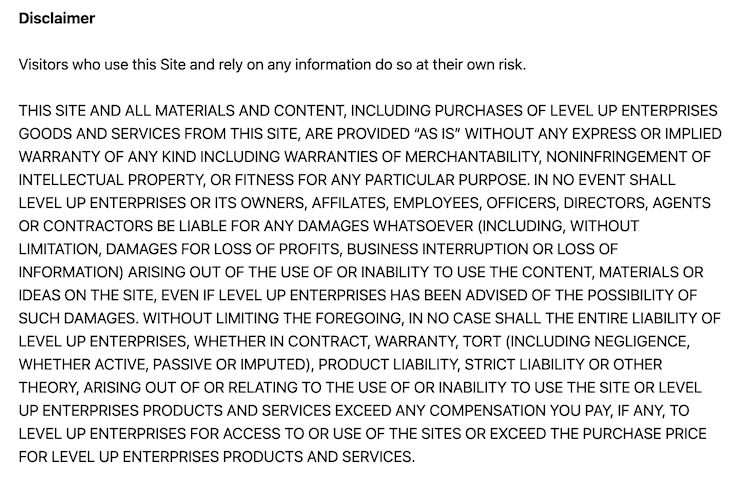
Their blog, which features health and wellness tips, features their health disclaimer in their terms and conditions and is similar to a no responsibility disclaimer.
While a disclaimer alone won’t protect you if you engage in actions that allow you to be sued (for example, false advertising), it can let the reader know that you’re fully aware of your rights and obligations and encourage them to exercise caution.
Copyright Disclaimer for Blog
Because you’re writing unique content or possibly referencing other people’s materials, your blog most likely needs copyright disclaimers.
There are two types of copyright disclaimers you might include on your blog:
- A disclaimer that announces your ownership of content.
- A fair use disclaimer that lets users know you’re using someone else’s copyrighted work under Section 107 of the Copyright Act.
Many blogs feature the first type of copyright disclaimer, which announces ownership of all content and intellectual property on the site.
Although you don’t need a copyright disclaimer to protect yourself from copyright infringement, including one can discourage theft and make it more challenging for potential copyright infringers to argue that their actions were unintentional.
A copyright blog disclaimer sample may look like the one found on the food blog My Food and Happiness, as shown in the screenshot below.
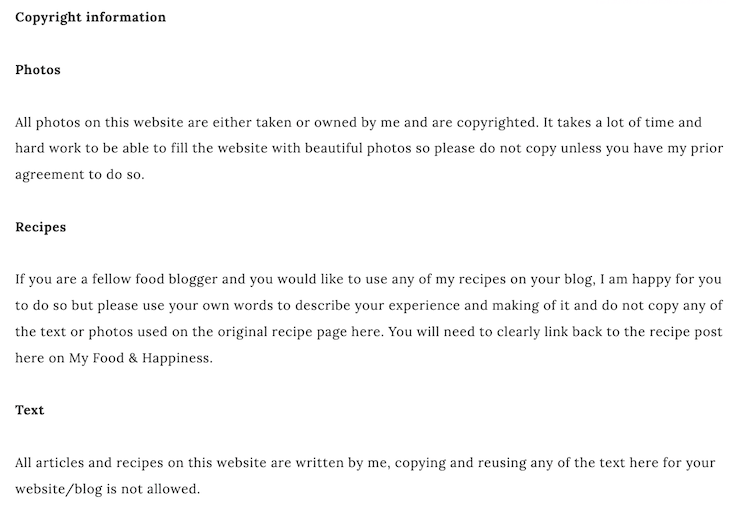
The disclaimer clearly states that all photos, recipes, and text on the website belong to the owner and should only be re-used with her express permission.
Writing your own copyright blog disclaimer may mean including the following:
- A statement that the website’s content (or specified content) belongs to you and is covered by US copyright law.
- A statement that users may not copy, reproduce, transmit, distribute, download, or otherwise transfer the website content (which can be tweaked depending on what you’d like your blog users to be able to do).
You also may want to include contact information where blog users can reach out if they have questions about your blog’s copyright policy or become aware of copyright infringement.
Although this isn’t an exhaustive list of all the different blog disclaimer samples available, it can help you determine which disclaimers you may need for your own blog.
Where to Post Your Blog Disclaimers
Once you have the proper disclaimers for your blog, you need to post them in several places so readers can easily find them.
Consider posting yours in the following locations, as necessary:
- On a dedicated disclaimer page
- In your terms and conditions agreement
- Linked to the footer of your website
- On specific blog posts and pages
- In the description of your social media posts
- In the description of your video posts
Summary
You now have the tools necessary to equip your blog with appropriate disclaimers so you can:
- Remove liabilities and responsibilities from your plate
- Keep your readers properly informed
- Properly disclose any material relationships or brand deals you’re part of
Posting blog disclaimers may help you avoid or prevent legal troubles and misunderstandings from your readers.
Make it easy on yourself and use our Disclaimer Generator to make different types of disclosures for your blog.

